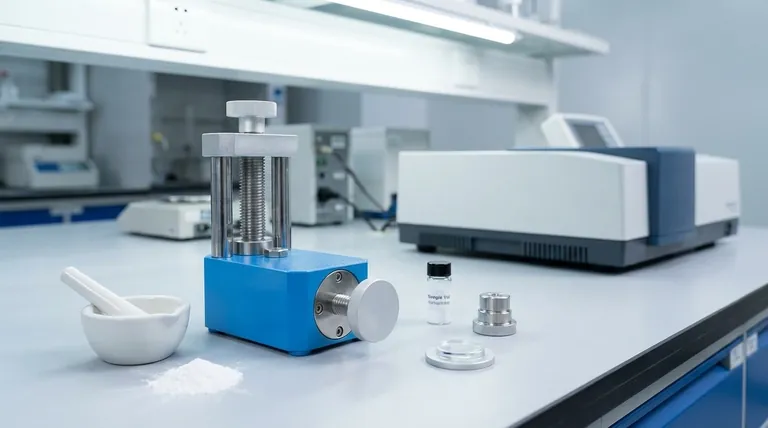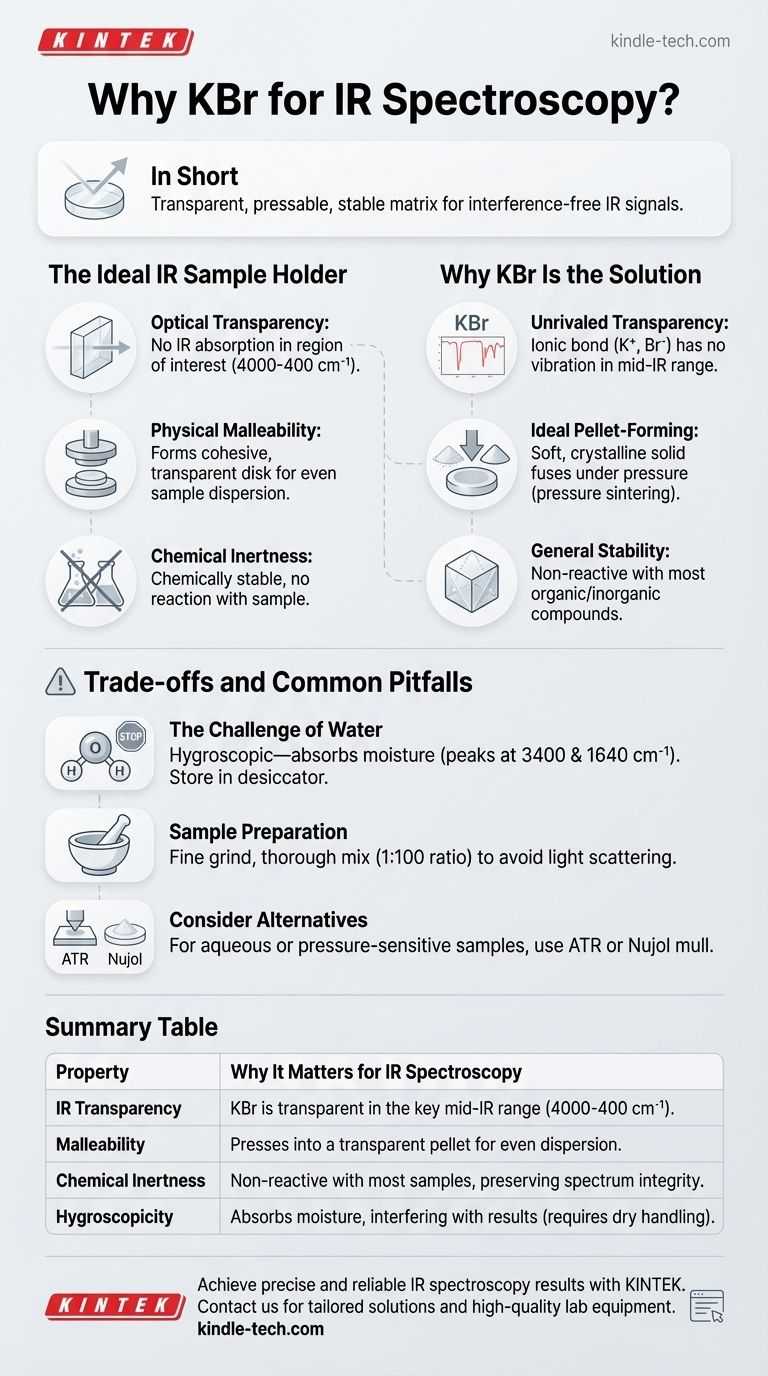In short, KBr is used for IR spectroscopy because it is transparent to infrared radiation and can be pressed into a solid, glass-like pellet. This process creates a stable matrix that holds the sample in the spectrometer's beam path without producing its own interfering signals in the most commonly analyzed spectral region.
The core reason for KBr's widespread use is not a single attribute, but a unique combination of optical transparency, chemical stability, and physical malleability that makes it an almost ideal medium for analyzing solid samples with infrared light.

The Essential Properties of an IR Sample Holder
To understand why KBr is the standard, we must first define the ideal characteristics for a material used to hold a solid sample for transmission IR analysis. The goal is to measure the sample, not the holder.
Requirement 1: Optical Transparency
The most critical requirement is that the material must not absorb infrared light in the region of interest. Any absorption from the holding material would create background noise that could obscure or be mistaken for signals from the actual sample.
The mid-infrared region, typically 4000 cm⁻¹ to 400 cm⁻¹, is where most functional groups in organic and inorganic compounds have their characteristic vibrations. An ideal material must be a "blank slate" in this window.
Requirement 2: Physical Malleability
The material must be able to encapsulate the sample uniformly. For solid samples, this means being a soft, crystalline solid that can be finely ground and then compressed under high pressure to form a cohesive, transparent disk.
This physical property ensures that the sample is dispersed evenly, minimizing light scattering and allowing the IR beam to pass through with minimal distortion.
Requirement 3: Chemical Inertness
The holding material must be chemically inert. It cannot react with the sample it is holding, as any chemical reaction would alter the sample's molecular structure and produce an inaccurate spectrum.
Why Potassium Bromide (KBr) Is the Solution
Potassium Bromide meets all the core requirements for solid-sample IR analysis, making it the default choice in laboratories worldwide.
Unrivaled Infrared Transparency
KBr is an alkali halide, a simple ionic salt. The ionic bond between potassium (K⁺) and bromide (Br⁻) does not have a vibrational frequency that falls within the mid-IR range.
As a result, a pure KBr pellet is almost completely transparent from 4000 cm⁻¹ down to about 400 cm⁻¹, providing a clean, interference-free background for measuring the sample.
Ideal Pellet-Forming Characteristics
KBr is a relatively soft, crystalline solid that is easily ground into a fine powder. When this powder is mixed with the sample and subjected to high pressure (as described in the pelleting process), the KBr crystals deform and fuse.
This process, known as pressure sintering, creates a homogenous, semi-transparent disk that locks the finely dispersed sample particles into a solid matrix, perfect for analysis.
General Chemical Stability
As a stable salt, KBr is non-reactive with the vast majority of organic and many inorganic compounds. This inertness ensures that the spectrum you measure is purely that of your original sample.
Understanding the Trade-offs and Common Pitfalls
While KBr is the standard, it is not without its challenges. Proper handling is critical for achieving accurate results.
The Challenge of Water
The most significant drawback of KBr is its hygroscopic nature—it readily absorbs moisture from the atmosphere. Water has very strong IR absorptions (a broad peak around 3400 cm⁻¹ and another near 1640 cm⁻¹).
If the KBr is not kept perfectly dry, these water peaks will appear in your spectrum, potentially obscuring important sample features. For this reason, KBr must be stored in a desiccator and handled quickly.
The Importance of Sample Preparation
The quality of the KBr pellet is paramount. The sample must be ground exceptionally fine and mixed thoroughly with the KBr powder, typically at a 1:100 sample-to-KBr ratio.
Improper grinding or mixing can lead to excessive light scattering (known as the Christiansen effect), which distorts the baseline of the spectrum and compromises the quality of the data.
When to Consider Alternatives
KBr is not universally applicable. For samples that are aqueous, sensitive to pressure, or reactive with bromide ions, other methods are necessary. Techniques like Attenuated Total Reflectance (ATR) or using a Nujol mull provide effective alternatives.
Making the Right Choice for Your Goal
Based on these principles, you can determine the best approach for your analysis.
- If your primary focus is routine analysis of stable solid compounds: The KBr pellet method is a cost-effective, reliable, and well-established technique, provided you meticulously control for moisture.
- If your sample is sensitive to moisture or cannot be ground: You must use an alternative method like ATR spectroscopy, which analyzes the surface of a sample directly without pellet preparation.
- If you need to analyze the Far-IR region (below 400 cm⁻¹): You must switch to a different window material, such as Cesium Iodide (CsI), as KBr itself begins to absorb in this lower frequency range.
Ultimately, KBr's selection as the industry standard rests on its powerful and practical combination of optical, physical, and chemical properties that are perfectly suited for transmission infrared spectroscopy.
Summary Table:
| Property | Why It Matters for IR Spectroscopy |
|---|---|
| IR Transparency | KBr is transparent in the key mid-IR range (4000-400 cm⁻¹), providing a clean background. |
| Malleability | It can be pressed into a transparent pellet that evenly disperses the sample for analysis. |
| Chemical Inertness | It is non-reactive with most samples, preserving the integrity of the spectrum. |
| Hygroscopicity | It absorbs moisture, which can interfere with results, requiring careful dry handling. |
Achieve precise and reliable IR spectroscopy results with the right equipment and consumables. KINTEK specializes in high-quality lab equipment and consumables, serving all your laboratory needs. Whether you require reliable materials for sample preparation or robust spectrometers, our expertise ensures your analytical processes are efficient and accurate.
Contact us today using the form below to discuss how we can support your research and quality control with tailored solutions. #ContactForm
Visual Guide

Related Products
- kbr pellet press 2t
- Laboratory Hydraulic Press Split Electric Lab Pellet Press
- Laboratory Manual Hydraulic Pellet Press for Lab Use
- Automatic Laboratory Hydraulic Pellet Press Machine for Lab Use
- Laboratory Hydraulic Pellet Press for XRF KBR FTIR Lab Applications
People Also Ask
- What is KBr disc method in IR spectroscopy? A Guide to Solid Sample Analysis
- What are the different types of sampling techniques used in IR spectroscopy? A Guide to KBr, Mull, and ATR Methods
- How much sample is needed for IR? Optimize Your Analysis with Minimal Material
- What are the safety precautions for KBr? Achieve Flawless FTIR Pellet Preparation and Data Accuracy
- Why use KBr to make the pellet? Achieve Clear, Accurate IR Spectroscopy Results



















